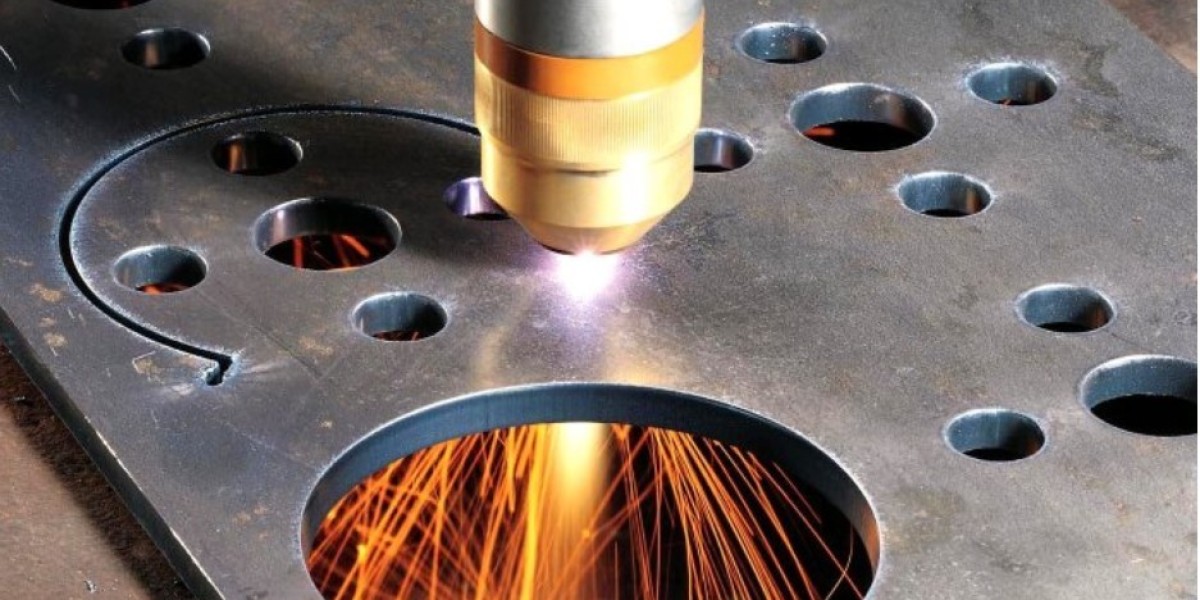CNC plasma cutting is a cornerstone of modern manufacturing, prized for its ability to cut through a variety of metals with speed, precision, and efficiency. By harnessing a high-temperature plasma arc, this cutting method creates clean, intricate designs, even on tough materials. Unlike traditional mechanical methods, CNC plasma cutting minimizes material distortion, reduces waste, and offers unparalleled flexibility.
Whether you’re crafting components for heavy machinery or producing artistic metalwork, CNC plasma cutting ensures consistent quality and reliability. This post explores the metals best suited for this process, the factors influencing their selection, and how to optimize outcomes for diverse applications.
Metals Suitable for CNC Plasma Cutting
CNC plasma cutting utilizes an electrically conductive gas—often a combination of oxygen, nitrogen, or argon—superheated into a plasma state. This plasma jet, directed through a narrow nozzle, melts the metal while a high-velocity gas stream expels molten material from the cut, creating precise edges. The CNC component automates the process, following pre-programmed instructions to produce detailed shapes and patterns with minimal manual intervention.
Plasma cutting relies on the electrical conductivity of metals to complete the circuit necessary for generating the plasma arc. Metals with high conductivity allow efficient energy transfer, resulting in faster, cleaner cuts. Non-conductive materials, like plastics or ceramics, cannot form the electrical connection required for plasma cutting CNC.
Some of the most common metals suitable for CNC plasma cutting include:
- Mild Steel: Its low carbon content and uniform structure make it easy to cut without cracking or deforming.
- Stainless Steel: Chromium content resists corrosion and maintains strength under the intense heat of plasma cutting.
- Galvanized Steel: The zinc coating protects against rust while remaining thin enough to enable clean cuts.
- Aluminum: Lightweight yet strong, its conductivity allows efficient cutting for various industrial applications.
- Copper: Exceptional thermal and electrical conductivity ensures clean cuts but requires precise control to manage heat dissipation.
- Brass: Durable and malleable, brass is ideal for decorative projects and specialized components.
Cutting Steel: Mild, Stainless, and Galvanized
CNC cutting services choose steel as the most versatile and widely used material in CNC plasma cutting, ranging from mild to stainless to galvanized varieties. Each type has unique characteristics that make it suitable for diverse applications, offering strength, durability, and resistance to environmental factors.
Mild Steel
Its low carbon content makes it soft and malleable, ensuring clean and precise cuts. Mild steel’s consistent structure minimizes the risk of cracking during cutting.
Applications:
- Automotive frames and parts.
- Structural components in construction.
- Agricultural machinery.
- Furniture and decorative designs.
Challenges: Excessive heat can cause warping, and post-cutting finishing may be required for smoother edges.
Stainless Steel
The chromium in stainless steel provides excellent corrosion resistance and retains strength under high temperatures. Its smooth surface enhances cutting precision.
Applications:
- Medical equipment and instruments.
- Food processing machinery.
- Architectural panels and fixtures.
- Chemical processing tanks.
Challenges: Heat discoloration can occur, and higher energy settings are needed for thicker pieces.
Galvanized Steel
The zinc coating protects the underlying steel from rust and corrosion, ensuring longevity in outdoor and humid environments.
Applications:
- HVAC systems.
- Outdoor signage.
- Roofing and fencing materials.
- Automotive exhaust systems.
Challenges: Zinc fumes can be hazardous, requiring proper ventilation during cutting.
Aluminum and Its Applications in Plasma Cutting
Aluminum’s unique properties make it a favorite in industries that demand lightweight yet durable materials. Its compatibility with CNC plasma cutting ensures high productivity and precision for various applications.
Aluminum’s excellent thermal and electrical conductivity allows efficient energy transfer during plasma cutting. Its lightweight nature makes it ideal for industries like aerospace and automotive, while its corrosion resistance extends its usability in harsh environments. However, its low melting point demands precise control to avoid warping or excessive material loss.
Applications
- Aircraft and aerospace components.
- Marine structures and boat hulls.
- Automotive body panels and lightweight frames.
- Architectural elements like curtain walls and decorative panels.
Challenges: Aluminum tends to produce dross during cutting, and its reflectivity can affect the accuracy of laser sensors in hybrid plasma systems. Advanced systems and skilled operators are essential to minimize these issues.
Using Plasma Cutting for Copper, Brass, and Other Alloys
Non-ferrous metals like copper and brass require specialized attention during CNC plasma cutting due to their unique properties. Their applications span industries like electronics, plumbing, and decorative arts.
Copper
High thermal conductivity ensures smooth cuts but requires careful control to prevent excessive heat absorption.
Applications:
- Electrical wiring.
- Plumbing fixtures.
- Heat exchangers.
Challenges: Heat dissipation can reduce cutting speed, necessitating powerful plasma settings.
Brass
Its alloyed composition combines strength, corrosion resistance, and malleability, making it versatile.
Applications:
- Musical instruments.
- Ornamental designs.
- Valves and fittings.
Challenges: Similar to copper, heat distortion is a concern.
Other Alloys
Nickel and titanium alloys, known for their strength and heat resistance, are ideal for aerospace and medical applications. These require advanced plasma cutting systems for optimal results.
Factors Affecting Metal Choice in Plasma Cutting Projects
Selecting the right metal for CNC plasma cutting involves understanding project requirements and material properties. Several factors influence this decision, ensuring cost-efficiency, durability, and quality outcomes.
Conductivity
The conductivity of a metal determines its ability to efficiently transfer the electrical energy needed to create a plasma arc. Metals with high electrical conductivity, such as copper and aluminum, enable smoother cutting as they facilitate better energy flow. This efficiency reduces the amount of power required for the cut, leading to faster and cleaner results. However, high conductivity can also mean rapid heat dissipation, requiring careful adjustment of plasma cutter settings to avoid uneven cuts or overheating. Poorly conductive metals may demand higher energy input, increasing costs and cutting time.
Thickness
The thickness of the metal plays a critical role in determining whether CNC plasma cutting is suitable for a project. Plasma cutters have a maximum cutting capacity based on their power output, and attempting to cut metal beyond this limit can result in incomplete cuts or rough edges. Thin metals are easier and faster to cut, while thicker materials require higher power settings and slower feed rates. For extremely thick metals, other methods, such as oxy-fuel cutting, might be more effective. Understanding the thickness ensures a balance between speed, precision, and cost-efficiency in the cutting process.
Corrosion Resistance
Corrosion resistance is vital when selecting metals for applications in challenging environments, such as those exposed to moisture, saltwater, or chemicals. Stainless steel and aluminum are popular choices due to their ability to resist rust and degradation over time. This resistance ensures the longevity of parts used in industries like marine engineering, construction, and outdoor signage. However, metals with protective coatings, such as galvanized steel, may pose challenges during plasma cutting because the coating can produce harmful fumes. Proper ventilation and safety measures are essential when cutting such materials to preserve their corrosion-resistant properties.
Cost and Availability
The cost and availability of metals are significant factors that directly affect the feasibility of a project. Common metals like mild steel and aluminum are widely available and relatively inexpensive, making them ideal for large-scale production. Specialty metals such as titanium or nickel alloys, while offering superior strength and heat resistance, are often more expensive and harder to source. The choice between affordability and performance depends on the project’s budget and requirements. Local availability also impacts logistics and delivery timelines, emphasizing the need for strategic sourcing to minimize delays and expenses.
Application-Specific Requirements
Different applications require metals with specific properties to meet performance and design criteria. For example, aerospace parts demand lightweight yet strong materials like aluminum, while food processing equipment relies on corrosion-resistant stainless steel to maintain hygiene. Similarly, decorative applications may prioritize aesthetics, favoring metals like brass or copper for their appearance. Understanding the end-use of the component ensures the selected metal aligns with functional and visual expectations, reducing the likelihood of failure or the need for redesign. Clear identification of these requirements early in the project streamlines material selection and cutting processes.
Post-Cutting Processes
The choice of metal also affects the type and extent of post-cutting processes required to achieve a finished product. Some metals, like mild steel, may require grinding or deburring to smooth edges, while others, such as aluminum, might need anodizing or polishing for enhanced durability or aesthetics. Metals with protective coatings may require touch-ups to restore their corrosion resistance after cutting. Factoring in these processes is crucial for accurate project planning, as they influence both cost and production time. Selecting metals that minimize additional processing can improve efficiency and reduce overall project expenses.
Conclusion
CNC plasma cutting is a versatile process capable of handling a wide range of metals, from mild and stainless steel to aluminum, copper, and brass. Each material has unique properties that make it suitable for specific applications, and understanding these properties is key to achieving the best results. Whether for industrial manufacturing or intricate artistic designs, plasma cutting ensures precision and efficiency. With proper machine settings and material selection, it continues to be an indispensable tool in modern manufacturing.



